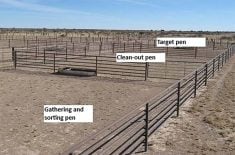A new bactericide offers a single dose choice for bovine respiratory disease injections of feeder calves.
The compound called Draxxin is newly licensed in Canada, but has been available in the United States for a year and Europe for two.
BRD is a highly contagious disease that results in more than $1 billion in losses in the North American cattle industry say experts.
John Campbell of the Western College of Veterinary Medicine in Saskatoon, Sask., said the industry welcomes new products to treat the problem.
Read Also

Teamwork and well-designed handling systems part of safely working cattle
When moving cattle, the safety of handlers, their team and their animals all boils down to three things: the cattle, the handling system and the behaviour of the team.
“Within the North American system of auction markets and pens of feedlot cattle coming from many different sources, if we have an effective treatment of at-risk or symptomatic cattle with as little handling as possible, it is a big deal for the industry,” said Campbell.
In the past, treating the various bacteria that cause BRD generally required two or three injections of drugs. With Pfizer’s Draxxin only one injection is necessary.
Draxxin belongs to the same family as Micotil and Nuflor, but remains in the tissues longer and can pass through the cell walls of the target bacteria in the animals’ lungs, said Kelly Lechtenberg, who operates Midwest Veterinary Services in Oakland, Nebraska, and specializes in the cattle feeding sector.
This combination puts more of the antibacterial agent in the bacterial cells, which disrupts the protein synthesis they need to remain alive and reproductive and keeps it there for a longer time without having to reinject the calves.
“Rounding up cattle over and over again isn’t doing anything for their already stressed conditions when they arrive at the feedyard,” said Lechtenberg.
“Most cattle feeders recognize that herd health programs based solely on vaccination and disease treatment regimens won’t pay the bills in the long term.”
He said reducing animal handling and labour costs is part of an overall strategy to increase profitability.
“In at-risk (of BRD) herds, a product like Draxxin fits in really well.”
Draxxin costs about $30 for a 100 millilitre bottle, enough to treat about 17 500-pound animals at a cost of $16 to $20 per head.
The retail price is set by individual veterinarians not the manufacturer.
The cost compares favourably to the popular Nuflor antibiotic and is slightly higher than Micotil. Both require multiple treatments.
“That’s where the savings are,” said Lechtenberg.
“That and with one treatment the problem of proper dosing over multiple applications drops.”
Pfizer veterinarian Les Byers said the economic benefit studies aren’t complete but so far the benefit over Micotil ranges from $16 to $100 per head when calves are treated with Draxxin upon entry to the feedlot.
“(Draxxin) remains at therapeutic levels for nine to 15 days,” Byers said.
“That is way beyond any other option out there and should help to cut the numbers of chronics in the yard.”
Lechtenberg said if producers look at the cost per day of treatment then “that sticker shock will go away pretty fast. This isn’t the only (antimicrobial) you’ll ever need, but it definitely adds a tool to the cattle feeder’s toolbox.”
The withdrawal time for beef animals is 44 days, making it inappropriate for veal calves.
As well, it is not intended for use on dairy cows older than 20 months. Cattle receive the single dose subcutaneously in the neck. It is also approved in swine for complex swine respiratory disease.
The product is in a glycol solution so it flows well and can be used in low temp














